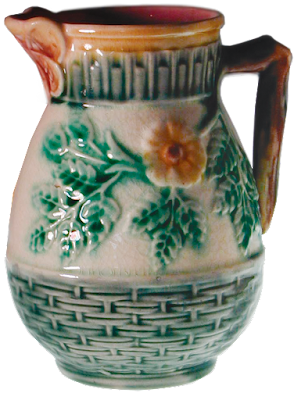As we saw in the first edition of Twins Separated at Birth, attribution in ceramics can be a tricky subject. Unless a piece is actually marked you can never be sure which pottery produced it. Majolica was produced for such a long time that factories often copied the work of other potteries. This is more common among the smaller potteries but it occasionally happened with larger potteries as well.
One well documented example is this figural of two cherubs carrying a barrel. The design certainly originated with Minton and was made in several versions including a version with each cherub on its own. They have all the design attributes of Minton. Yet the design was also successfully copied by Holdcroft. The Holdcroft version included a flower frog which made clear the intended use as a centerpiece. The Minton versions could be used for anything. I've never seen one with a flower frog from Minton though they may have made them. Both potteries signed their work and used glazes distinctive to their factories, leaving no question to the attribution.
Minton version with cherubs holding an oval barrel
| Minton version with cherubs holding a round barrel |
Minton example that substitutes a shell for the barrel
|
Holdcroft version with a round barrel and flower frog
|
|
Another commonly seen twin is the rope and acanthus leaf cheese bell. These are generally attributed to Forester but the original was registered by Joseph Roth, London. When Roth folded after just a few years in production Forester purchased their majolica molds. The Roth examples are marked; the Forester examples of the same design were not. However we know Forester made the piece because it appears in advertising from the company catalog. In addition to Forester other companies copied the design as well including the Bendigo Pottery of Australia.
Joseph Roth majolica cheese bell
|
 |
Bendigo Pottery fern and rope (PHOTO: MAAS)
|
Another well known piece, the monumental Wedgwood fish platter, has its own twins but the makers are unknown. The MIS has suggested that one of the makers may be Holdcroft but I have never seen one marked as such. The quality is variable on these though it is often quite as good as the Wedgwood original.
Wedgwood majolica fish platter
Holdcroft majolica fish platter
One commonly found majolica twin is the Copeland cauliflower teapot but in this case the twin, made by the Etruscan Works of Phoenixville, PA is more well known than the Copeland original. Very popular with collectors the GSH designers created a complete service of dessert wares around the teapot. To the best of my knowledge matching pieces were not made for the Copeland original.
Copeland majolica cauliflower teapot
|
Etruscan majolica cauliflower teapot
|
|
Since we're discussing Etruscan twins the GSH bird and iris teaset is a slightly altered twin of Forester's own bird and iris teaset.
 |
| GSH bird and iris teaset |
 |
| Forester bird and iris teaset |
With an English designer–most likely Hamlet Bourne of Staffordshire–the Etruscan Works copied many original British designs creating American twins of their English cousins. Even the most famous Etruscan piece, their baseball pitcher, is an adaptation of Wedgwood's cricket jug.
GSH majolica baseball jug
Wedgwood majolica cricket jug
Among the other "twins" of European majolica created by the Etruscan Works are the E-3 butterfly pitcher after a jug by Forester; the lily dessert stand; the C-7 geranium cake tray; the E-12 corn pitcher from a BWM original; the C-11 strawberry server from a Wedgwood original; the E-5 corn creamer; the K-2 cow butter from a GJ original; the N-14 sardine dish also from a GJ original; the E-1 straight side jug from a Wedgwood original; the Asian peasant plate from a Choisy Le Roi original; the A-6 pansy pat from a Copeland pat; the A-1 pond lily pat from a GJ original; and the A-7-2 pat. Many of these copies were specifically intended to undercut the sales of the more expensive imported versions.
Etruscan Majolica E3 pitcher
Forester majolica pitcher
Other copies exist from other potteries of course but if I were to list them all I'd be here all day. Still, this gives a good idea how common the practice of "twinning"was.

















I have a creamed corn covered canister with the number 55 on the bottom of the base. Would like to sell it and to know how much it's worth. It is in good condition with a few small marks inside the lid.
ReplyDeleteI’m sorry, I don’t give price evaluations on this blog.
ReplyDelete